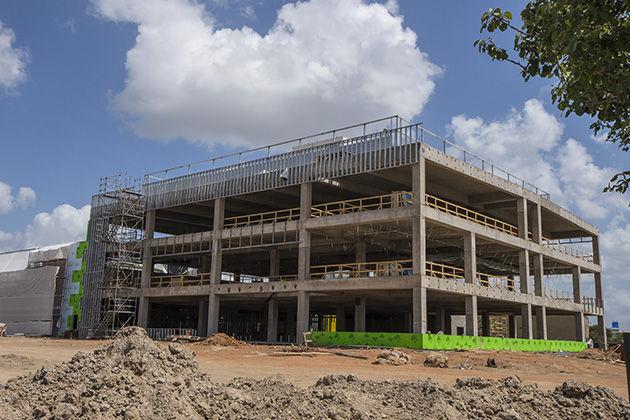The plan and its numbers are staggering — 25,000 engineering students by 2025 — but this semester Texas A&M will experience growth on par with its engineering expansion goals.
Roughly 268,000 square feet will be either added or under construction by January 2015 as the Dwight Look College of Engineering greets its first freshmen class admitted under the 25 by 25 Initiative. All engineering classes will number less than 100 students, faculty and staff hires are on the rise and freshmen are no longer admitted directly into a degree-granting major.
The construction is just one benchmark in an across-the-board expansion effort within the Look College as 25 by 25 finishes its second year, as administrators across Texas A&M work to ensure that the infrastructure is in place by 2025 for 25,000 engineering students.
1 Semester, 3 Projects
Two new engineering facilities will be opened and the Zachry Engineering Center will begin its transformation into the Engineering Education Complex (EEC) by January 2015, said Tell Butler, director of engineering facilities.
An “Engineering Village” consisting of eight new greenhouse-inspired buildings will be built in front of the Student Computing Center between Lamar and Lubbock streets, where agricultural greenhouses previously stood. These engineering activities buildings will cost roughly $4 million and will add 36,000 square feet of engineering undergraduate classrooms, Butler said.
“Six [greenhouses] will become first year engineering student classrooms,” Butler said. “The maximum capacity in each classroom will be 100 students, and the other [greenhouses] will become office spaces.”
The Engineering Research Building is under construction in Research Park and will be partially opened by December, with the full building opened by March 2015. The ERB will house research labs and will include a nanotechnology group and an energy institute and is expected to cost $23 million for its 32,000 square feet, Butler said.
Butler said all departments, labs and classrooms will be moved out of the Zachry Engineering Center by December and construction will begin January 2015.
“We’re going to take [Zachry] down to the bare structural frame and we’re going to renovate it and we’re going to add an additional 200,000 square feet to it,” Butler said. “The new building will house multiple flexible lab spaces, classrooms, administration spaces and shop areas for rapid prototyping.”
Increased Enrollment, Smaller Class Sizes
Construction moves fast, but student and faculty numbers are keeping pace.
Around 3,000 freshmen students were admitted into engineering this fall ,said Katherine Banks, Dean of the Dwight Look College of Engineering. While Texas A&M does not release the number of enrolled students until the 20th class day, this fall’s enrollment will mark an increase of several hundred engineering students over fall 2013 if they hold.
Banks said skepticism over the affect increased enrollment might have on the college’s educational worth is unfounded, and she said the college will increase both its numbers and quality this semester through 25 by 25. The number of national merit scholars in the engineering freshmen class is up 22 percent and the average combined SAT scores are now higher than 1300 — an 11-point rise compared to last year.
“We let more students in, and we increased our SAT and ACT,” Banks said. “That’s an amazing statistic, to think that in fact we improved quality (through) 25 by 25.”
This year’s engineering freshmen class enrolled as general engineering majors and students now apply to specific departments after completing at least one semester.
Despite enrollment increases, Banks said the engineering college has successfully lowered every engineering class size to no more than 100 students. The 100-student limit does not apply to courses taught by the college of science, such as introductory physics and math.
“We had to split some classes up,” Banks said. “We had to really think about how we wanted to align the courses, but we did it because it was a commitment that I had in terms of the principles of 25 by 25.”
Building new facilities such as the Engineering Village contributed to the enrollment increase and the 100-student class cap, said Banks.
“Those classrooms will be state-of-the-art, hands-on, experiential-learning classrooms just for our first-year students,” Banks said in reference to the Engineering Village. “Note that when you have 3,000 (students) you have the need for lots of large classrooms.”
The enrollment increase is also due to the debut of the Texas A&M Engineering Academy at Blinn. The 3,000 admitted engineering freshmen include about 250 students participating in the Academy’s second year this fall.
Teri Reed, Assistant Vice Chancellor for Academic Affairs, said students enrolled in the invitation-only academy take their engineering courses from Texas A&M faculty while taking their core curriculum courses at Blinn.
“These students will progress through the engineering program in-step with fellow engineering A&M students and can achieve an engineering degree from the (Look College) at the same graduation rate as their peers,” Reed said.
Reed said the academy’s participants will apply and be considered for an engineering major with other A&M students upon successful completion of the academy’s program.
Faculty and staff numbers are also on the rise. Banks said 63 additional tenure-track faculty positions have been filled since 25 by 25 began along with 25 new instructional faculty positions and 12 new Professors of Practice.
Millions spent on construction, increased faculty presence and smaller class sizes — 10 years remain before 2025, but this semester’s investment sets the tone for those changes to come.
Texas a&m’s Engineering overhaul
September 1, 2014
The Engineering Research Building will house nanotechnology and energy research labs, among others, when it is completed.
0
Donate to The Battalion
$2790
$5000
Contributed
Our Goal
Your donation will support the student journalists of Texas A&M University - College Station. Your contribution will allow us to purchase equipment and cover our annual website hosting costs, in addition to paying freelance staffers for their work, travel costs for coverage and more!
More to Discover










